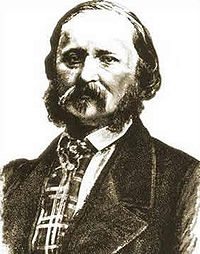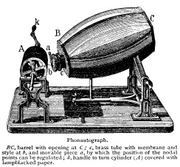
Édouard-Léon Scott de Martinville
Encyclopedia

France
The French Republic , The French Republic , The French Republic , (commonly known as France , is a unitary semi-presidential republic in Western Europe with several overseas territories and islands located on other continents and in the Indian, Pacific, and Atlantic oceans. Metropolitan France...
printer and bookseller who lived in Paris
Paris
Paris is the capital and largest city in France, situated on the river Seine, in northern France, at the heart of the Île-de-France region...
. He invented the earliest known sound recording device, the phonautograph
Phonautograph
The phonautograph is the earliest known device for recording sound. Previously, tracings had been obtained of the sound-producing vibratory motions of tuning forks and other objects by physical contact with them, but not of actual sound waves as they propagated through air or other media. Invented...
, which was patented in France on 25 March 1857.
Early years
As a printer by trade, he was able to read accounts of the latest scientific discoveries and became an inventor. Scott de Martinville was interested in recording the sound of human speech in a way similar to that achieved by the then new technology of photography for light and image. He hoped for a form of stenography that could record the whole of a conversation without any omissions. His earliest interest was in an improved form of stenography and he was the author of several papers on shorthandShorthand
Shorthand is an abbreviated symbolic writing method that increases speed or brevity of writing as compared to a normal method of writing a language. The process of writing in shorthand is called stenography, from the Greek stenos and graphē or graphie...
and a history of the subject (1849).
Phonautograph

Eardrum
The eardrum, or tympanic membrane, is a thin membrane that separates the external ear from the middle ear in humans and other tetrapods. Its function is to transmit sound from the air to the ossicles inside the middle ear. The malleus bone bridges the gap between the eardrum and the other ossicles...
, a series of levers for the ossicle, which moved a stylus he proposed would press on a paper, wood or glass surface covered in lampblack. On 26 January 1857, he delivered his design in a sealed envelope to the French Academy.
On 25 March 1857, he received French patent #17,897/31,470 for the phonautograph.
The phonautograph used a horn to collect sound, attached to a diaphragm which vibrated a stiff bristle
Bristle
A bristle is a stiff hair or feather. Also used are synthetic materials such as nylon in items such as brooms and sweepers. Bristles are often used to make brushes for cleaning uses, as they are strongly abrasive; common examples include the toothbrush and toilet brush...
which inscribed an image on a lamp black coated, hand-cranked cylinder. Scott built several devices with the help of acoustic instrument maker Rudolph Koenig
Rudolph Koenig
Karl Rudolph Koenig , known by himself and others as Rudolph Koenig, was a German physicist, chiefly concerned with acoustic phenomena.Koenig was born in Königsberg , and studied at the University of Königsberg in his native town....
. Unlike Edison
Thomas Edison
Thomas Alva Edison was an American inventor and businessman. He developed many devices that greatly influenced life around the world, including the phonograph, the motion picture camera, and a long-lasting, practical electric light bulb. In addition, he created the world’s first industrial...
's later but similar invention of 1877, the phonograph
Phonograph
The phonograph record player, or gramophone is a device introduced in 1877 that has had continued common use for reproducing sound recordings, although when first developed, the phonograph was used to both record and reproduce sounds...
, the phonautograph only created visual images of the sound and did not have the ability to play back its recordings. Scott de Martinville's device was used only for scientific investigations of sound waves.
Scott de Martinville managed to sell several phonoautographes to scientific laboratories for use in the investigation of sound. It proved useful in the study of vowel sounds and was used by Franciscus Donders
Franciscus Donders
-External links:* B. Theunissen. , F.C. Donders: turning refracting into science, @ History of science and scholarship in the Netherlands.* in the Virtual Laboratory of the Max Planck Institute for the History of Science* P. Eling, , Geneeskundige en fysioloog....
, Heinrich Schneebeli and Rene Marage. It also initiated further research into tools able to image sound such as Koenig's manometric flame
Koenig's manometric flame apparatus
Koenig's manometric flame apparatus was a laboratory instrument invented in 1862 by the German physicist Rudolph Koenig, and used to visualize sound waves. It was the nearest equivalent of the modern oscilloscope in the late nineteenth and early twentieth centuries.-Description:The manometric...
. He was not, however, able to profit from his invention and spent the remainder of his life as a librarian and bookseller at 9 Rue Vivienne in Paris.
Scott de Martinville also became interested in the relationship between linguistics, people's names and their character and published a paper on the subject (1857).
Rediscovery of the Au Clair de la Lune recording
In 2008, the New York Times reported the discovery of a phonautogram from 9 April 1860. The announcement of the discovery was accompanied by an announcement that the visual recording was made playable — "converted from squiggles on paper to sound — by scientists at the Lawrence Berkeley National LaboratoryLawrence Berkeley National Laboratory
The Lawrence Berkeley National Laboratory , is a U.S. Department of Energy national laboratory conducting unclassified scientific research. It is located on the grounds of the University of California, Berkeley, in the Berkeley Hills above the central campus...
in Berkeley, California
Berkeley, California
Berkeley is a city on the east shore of the San Francisco Bay in Northern California, United States. Its neighbors to the south are the cities of Oakland and Emeryville. To the north is the city of Albany and the unincorporated community of Kensington...
." The phonautogram was one of Leon Scott's forgotten images in Paris; they were scanned then processed by a sophisticated computer program developed a few years earlier by the Library of Congress
Library of Congress
The Library of Congress is the research library of the United States Congress, de facto national library of the United States, and the oldest federal cultural institution in the United States. Located in three buildings in Washington, D.C., it is the largest library in the world by shelf space and...
.
The recording was a ten-second snippet of a singer, originally thought to be the daughter of the inventor, before it was discovered that the recording was played at twice normal speed and was probably his own voice, performing the French folk song "Au Clair de la Lune". This phonautograph recording is now the earliest known recording of a human voice and music in existence, predating, by twenty-eight years, the longest surviving Edison
Thomas Edison
Thomas Alva Edison was an American inventor and businessman. He developed many devices that greatly influenced life around the world, including the phonograph, the motion picture camera, and a long-lasting, practical electric light bulb. In addition, he created the world’s first industrial...
phonographic recording of a Handel chorus from the oratorio "Israel in Egypt", made in 1888.
A phonautogram by Scott de Martinville containing the opening lines of Torquato Tasso
Torquato Tasso
Torquato Tasso was an Italian poet of the 16th century, best known for his poem La Gerusalemme liberata , in which he depicts a highly imaginative version of the combats between Christians and Muslims at the end of the First Crusade, during the siege of Jerusalem...
's pastoral drama Aminta
Aminta
Aminta is a play written by Torquato Tasso in 1573, represented during a garden party at the court of Ferrara. Both the actors and the public were noble persons living at the Court, who could understand subtle allusions the poet made to that style of life, in contrast with the life of shepherds,...
has also been found. Recorded around 1860, probably after the recording of Au Clair de la Lune, this phonautogram is the earliest known recording of human speech to be played back. Earlier recordings made in 1857 contain Scott's voice, too, but are unrecognizable due to the irregularity of speed.
There is an urban legend
Urban legend
An urban legend, urban myth, urban tale, or contemporary legend, is a form of modern folklore consisting of stories that may or may not have been believed by their tellers to be true...
that a recording was made of Abraham Lincoln
Abraham Lincoln
Abraham Lincoln was the 16th President of the United States, serving from March 1861 until his assassination in April 1865. He successfully led his country through a great constitutional, military and moral crisis – the American Civil War – preserving the Union, while ending slavery, and...
's voice, supposedly made using Scott's Phonautograph in Washington D.C. in 1863. The legend claims that a phonautographic tracing of Lincoln's voice was supposedly included among the artifacts kept by Edison. According to the researchers at FirstSounds.org, Scott did not travel to the U.S. in the 1860s.
Scott de Martinville's phonautograms were selected by the Library of Congress
Library of Congress
The Library of Congress is the research library of the United States Congress, de facto national library of the United States, and the oldest federal cultural institution in the United States. Located in three buildings in Washington, D.C., it is the largest library in the world by shelf space and...
as a 2010 addition to the National Recording Registry
National Recording Registry
The National Recording Registry is a list of sound recordings that "are culturally, historically, or aesthetically important, and/or inform or reflect life in the United States." The registry was established by the National Recording Preservation Act of 2000, which created the National Recording...
, which selects recordings annually that are "culturally, historically, or aesthetically significant".
Publications
- Jugement d'un ouvrier sur les romans et les feuilletons à l'occasion de Ferrand et Mariette (1847)
- Histoire de la sténographie depuis les temps anciens jusqu'à nos jours (1849)
- Les Noms de baptême et les prénoms (1857)
- Fixation graphique de la voix (1857)
- Notice sur la vie et les travaux de M. Adolphe-Noël Desvergers
- Essai de classification méthodique et synoptique des romans de chevalerie inédits et publiés. Premier appendice au catalogue raisonné des livres de la bibliothèque de M. Ambroise Firmin-Didot (1870)
- Le Problème de la parole s'écrivant elle-même. La France, l'Amérique (1878)
Further reading
- Helmholtz, Hermann. On the Sensations of Tone as a Physiological Basis for the Theory of Music. Translated by Alexander J. Ellis. London: Longmans, Green, 1875, p. 20.
- History of the Phonautograph Marco, Guy A., editor. Encyclopedia of Recorded Sound in the United States. New York: Garland, 1993, p. 615.
- Winston, Brian. Media Technology and Society: a History from the Telegraph to the Internet. New York : Routledge, 1998.
External links
- FirstSounds.org
- The Phonautographic Manuscripts of Édouard-Léon Scott de Martinville (PDF), containing French and English texts of all Scott's known writings about the phonautograph from the 1850s and 1860s.
- Read in Serbian on muzickacenrala.com

